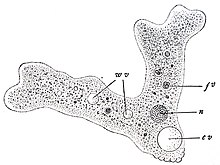ectoplasm
The ectoplasm , also known as external plasma or ectosark, is the outer layer of the cytoplasm of many unicellular organisms. The inner part of the cytoplasm, on the other hand, is called the endoplasm , whereby the two types of plasma are not fundamentally different, but only differ from one another in their consistency and different distribution of intraplasmic organelles.
Layout and function
In contrast to the endoplasm, the ectoplasm does not contain any organelles . It appears homogeneously translucent under the microscope and has a gel-like consistency with a higher viscosity (plasma gel) than the thinner sol of the endoplasm (plasma sol). It is rich in the normal case of fibrillar proteins , mainly actins , which auxiliary proteins such fimbrin , a-actinin and Filamin can be networked to form a rigid gel. This stiffening is controlled by the concentration of calcium (Ca 2+ ), whereby the structures dissolve at higher Ca 2+ concentrations and the plasma changes to a sol state.
Especially when pseudopodia are formed , the two components mix (gel-sol transitions); the ectoplasm liquefies and flows towards the pseudopodium, while the endoplasm flows into the pseudopodium and becomes more viscous at the edge. When uncoated amoebas move , there is a contraction in the ectoplasm mediated by actin, causing the liquid endoplasm to develop a current and flow into the pseudopodium.
Individual evidence
- ↑ a b Keyword "Endoplasma" in: Herder-Lexikon der Biologie. Spectrum Akademischer Verlag GmbH, Heidelberg 2003. ISBN 3-8274-0354-5 .
- ^ A b c Keyword “Ectoplasm” in: Herder-Lexikon der Biologie. Spectrum Akademischer Verlag GmbH, Heidelberg 2003. ISBN 3-8274-0354-5 .
